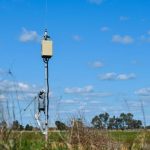
Dairy Australia released its February Situation and Outlook report last week, which said northern Victoria had seen a ‘‘particularly large drop in volumes in year-on-year terms, due to the confluence of dry conditions, high purchased feed prices, and expensive irrigation water’’.
In December, northern Victoria’s milk production dropped 22.6 per cent compared to December 2017 and the region’s year-to-date production sits at 899.5litres, down 14.7 per cent on last season.
The flow-on effect of northern Victoria’s situation is Dairy Australia forecasting the 2018-19 national milk pool to be between 8.45 and 8.65 billion litres — or a seven to nine per cent drop — on the previous year.
The tough conditions are forcing many dairy farmers to leave the industry, while others are cutting milking herd numbers or selling young stock to survive.
Cohuna dairy farmer Miriam Crane has been forced into parking 74 head in South Gippsland to protect her core genetics, and has sold the rest of her herd and put her property up for sale.
‘‘Temporary water has gone from $200 to over $500, hay from $180 tonne to $500 and grain from $370 to $520,’’ Ms Crane said.
‘‘I was losing money every single day just to keep my cows fed and financially I just couldn’t continue.
‘‘I hope the decisions I have made will help me get back into the industry in 12 months’ time.’’
Greenhams livestock group manager Graeme Pretty said cull numbers were up at least 30 per cent and were not slowing down, while herd testing and milk analysis business National Herd Development Co-op in Cohuna has lost 14 dairy farms from its books since January.
The Situation and Outlook report revealed wheat prices increased by 61 per cent and hay prices increased by 227 per cent in the Goulburn and Murray valleys in the year to January 2019.
The average price of traded water has increased by 188 per cent on last year in northern Victoria and 204 per cent in the Murray Irrigation System area.
Despite farmers feeling the pinch, there is some upside to the broader industry with global dairy markets revealing healthy import demand, and growth in key markets including China (up three per cent), Japan (up five per cent) and South-East Asia (up six per cent).
Dairy Australia’s senior industry analyst John Droppert said the figures provide some comfort for the Australian dairy industry.
‘‘It’s easy to lose sight of the positive in an environment of rising costs of production, a challenging domestic market and tough seasonal conditions,’’ Mr Droppert said.
‘‘As well as overseas, there are opportunities closer to home, and premium offerings are selling well in the Australian domestic market, generating increased unit value.’’
Looking ahead, the report suggested potential for resurgent global milk production and a price constrained domestic retail market would limit the positive impacts of a weaker Australian dollar and strong international demand when it comes to easing pressures on farmers.

























